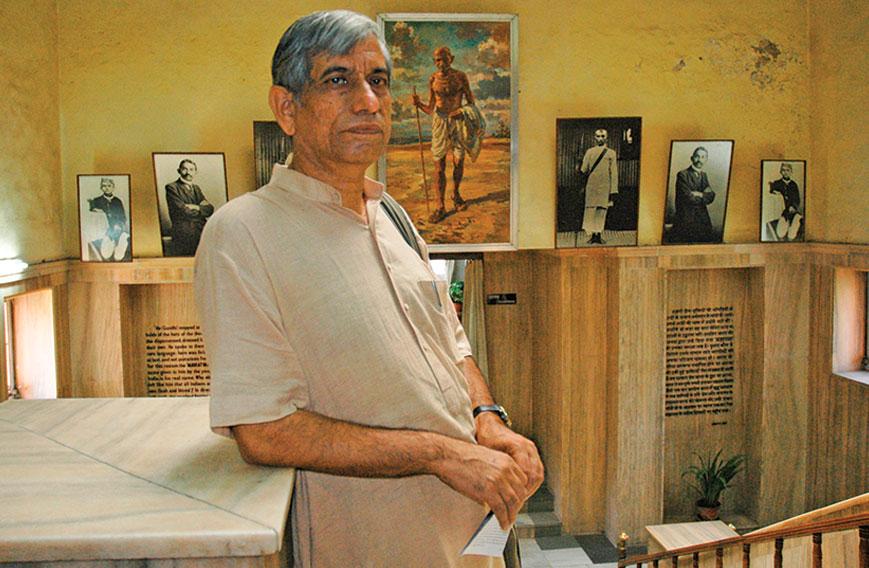By: Subhashini
NEW DELHI: Anupam Mishra, who breathed his last on December 19, 2016 following cancer, is feted as India’s waterman, and rightly so. His work “Aaj bhi khare hain talaab” (Ponds are still relevant) that published in 2011, is not just a book but also an inspirational reality.
Through his work he made the public aware as to how people in water-scarce regions of Rajasthan preserved every drop of rain water, that it would suffice them for the entire year. Here’s my tribute to the waterman of India.
I’ve heard a lot about Anupam Mishra from my father since I was a child. Back then, I was a little surprised as to why my father brought him up every now and then. My father was writing a documentary titled – “The Journey of water: From Peaks to the Oceans” when he met Anupam Mishra for the first time, at the Gandhi Peace Foundation. His personality and perspective was really awe-inspiring. Anupam Mishra was quite unpretentious and straightforward. He used to sit in a rather ordinary room with lots of files and books. He gifted my father his book, Aaj Bhi Khare Hain Talaab. Father already knew a lot about Mishra’s work through his friend’s father, Anant Mankapure, who was a famous painter.
“Aaj Bhi Khare Hain Talaab”, basically is a report based book and talks about how every household in arid regions could have their own water harvesting facility, a technique that has been in place for centuries. His approach towards life was something we do not find easily in the modern times. Moreover, to my surprise this book has no copyright and can be reprinted and republished as and when one wants to. It intrigues me as to how this book had such an impact on the public, and on the society as a whole.
“Aaj Bhi Khare Hain Talaab”(Ponds are still relevant) is probably one of the greatest books in Hindi which talks extensively on the subject of water conservation and preservation of environment.
It is considered to be all time greatest creative books, not only as stated by Tehelka but also by many other publications.
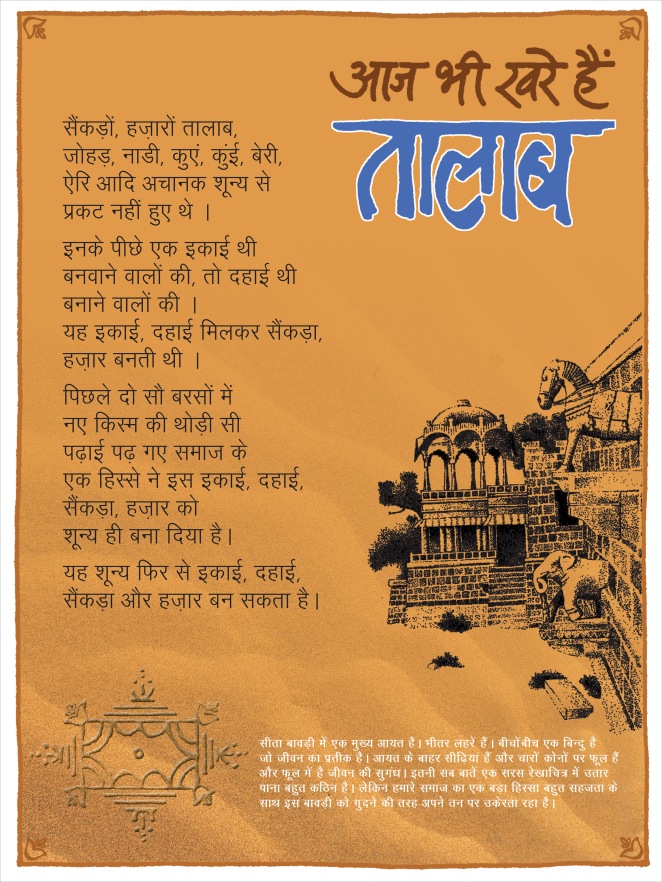
According to the data provided by India Today, this book holds a place in the list of best thirty books that have been published so far (Gita and Ramayana are also a part of the list). This book has been translated in almost all Indian languages and quite a few foreign languages as well. There also exists a Braille version of this book and around two lac copies have been sold so far.
The book focuses on how to save the ancient water resources which have been neglected for quite a long time in India. When it got published, it attracted the attention of a huge chunk of people.
Magsaysay Award winner Rana Rajendra Singh explained that this book tremendously contributed towards the success of his institution “Tarun Bharat Sangh” which created a vital awareness for water conservation in Rajasthan. Anil Agarwal and Anupam Mishra were the very first members of this organisation, Mishra being the president here for a long time. These two have provided a strong base to this work, and Rajendra Singh has laid the groundwork of coming up with an alternative infrastructure for water in Alwar, which is indeed a great example for the nation.
.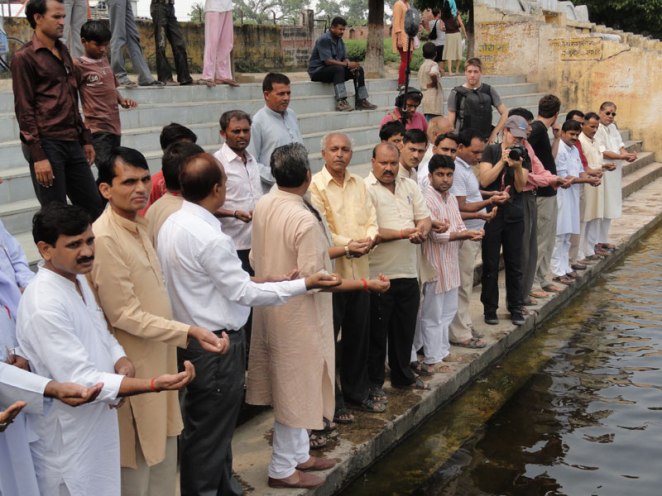
Tarun Bharat Sangh taking an oath to save the river Shiv Ganga
The establishment of Centre for Science and Environment became possible because of Anupam Mishra’s valuable contribution.
His efforts to revive the Arvari river are praiseworthy and this work gave him a distinguished recognition and identity. During a TED Talk, he divulged what the simple lines of a baoli’s motif that is a common tattoo among villagers signify.
Mr BR Naidu, a collector in the district Sagar in Madhya Pradesh was so influenced and impressed by this book that he started a movement – “Apne Talaab bachao, Prashasan aaj Nahi to Kal Chetega” (Save our ponds, sooner or later the Administration will look into the matter) His efforts brought a tremendous change and about one thousand ponds were revived in his district Sagar.
Similarly In the district Shivpuri of MP, almost three hundred and forty ponds were revived. The collectors of two known districts Sidhi and Damoh of Madhya Pradesh distributed hundreds of copies of the book to the public.
Bhuj, a district in Gujarat which is prone to water scarcity also saw some amazing improvements. The diamond merchants were so inspired by the idea that they started a new movement aimed towards water conservation in their area. This book largely inspired the Saurashtra area for water conservation.
This book has given a new life to many small societies of Rajasthan, even when they already knew so many techniques for water conservation beforehand. A number of ponds have been revived and a drought area in Rajasthan, known as Laporiya has shown commendable advancement by saving their water resources and meadows. Because of enough supply of water, almost three hundred houses have well-fed dairy cattle and hence provide milk to the Jaipur dairy.
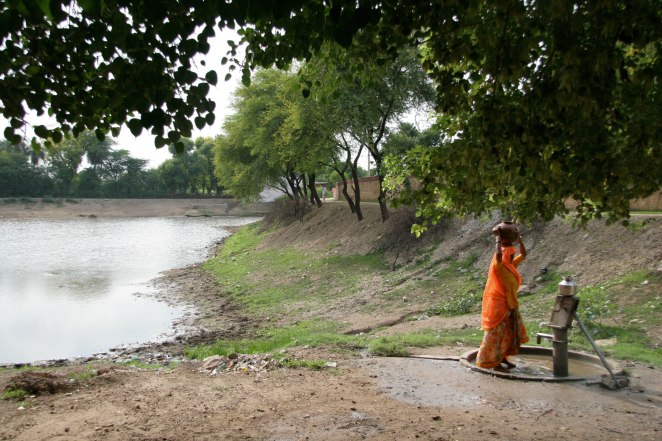
Laporiya: A village that has been saving raindrops for thirty years
Uttaranchal was yet another state that was influenced greatly. Sachchidanand Bharti from Lok Vikas Sansthan Dudhatoli under the area of Ufrekhal , Pauri Garhwal started the work to rejuvenate the chals (A small pond to conserve water in hilly area) in the area. In the last thirteen years, he has given a new life to about thirteen thousand chals.
Besides that, Karnataka has taken the work of water resource conservation in its own hands. A new organisation known as “Jal Samvardhan Yojna Sangh”, with the help of World Bank came up with a large scale plan to save the ponds in the whole state. Sudha Murthy, wife of Narayan Murthy, owner of Infosys in Karnataka has translated this book in Kannada and has sent around fifty thousand copies to every panchayat of the state.
A translation of this book was published in a magazine named ‘Tarkash’ in Malerkotla, a tehsil in the Sangrur district in Punjab. After a while, a brief Punjabi addition was also published and distributed for free. Later on, a new book was published in congruity with the territory of Punjab which influenced literature, critics, folk singers, social and religious institutions, and the Gurudwara committee members as well. The folk singers of Punjab have made efforts to spread awareness to save the water resources in their own kind of way.
Anupam Mishra always worked towards environment preservation and ecological balance with utmost dedication, and wanted to attract the attention of Government towards the same. He put in a lot of effort in understanding India’s traditional environment and life systems. The Tawa Dam built on the Narmada in the 70s caused a serious problem of bog in the entire Hoshangabad district. Anupam Mishra was the first one to raise a voice against it and initiated and propagated the “Mitti Bachao Andolan”, prior to the “Narmada Bachao Andolan.”
Anupam Mishra was an epitome of courage and his work is very much a reflection of his personality. Rajendra Singh referred to him as a fearless and a transparent person, who led a much disciplined life. When Singh met him in the hospital, he saw that there was no fear of death on his face and that he spoke with the same courage and enthusiasm as always. He instilled a sense of pride among local communities about their traditional knowledge, at a time when this knowledge is being forgotten and modern technology is taking over. He was a peculiar example of love towards nature. He was a seeker of folk life and science and believed that science is not limited only to the labs, a common man also bears the scientific knowledge which has been moulded in the shape of various traditions over the years.
Mishra adopted a very meditative and spiritual approach to understand the problems of the society and the world as a whole and acknowledged the direct relationship between natural resources and human needs. He believed in understanding the dimensions of relationship between progress and tradition rather deeply. He also worked with Chandi Prasad Bhatt in the Chipko Movement to protect forests.
A number of environment protection projects throughout the world have taken inspiration from the work of Anupam Mishra. It inspired a lot of people to take the agenda of environment protection pretty seriously.
He wrote 17 books in his lifetime. “Rajasthan ki rajat boondein” & “Hamara Paryavaran” etc. are some of his pieces, his last one being “Mahasagar Se Milne Ki Katha”.
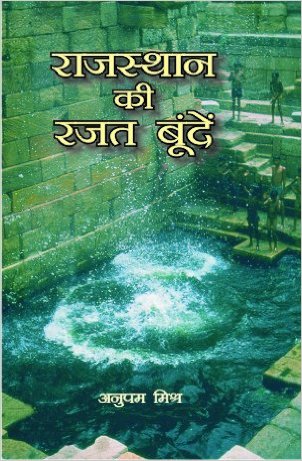
Rajasthan Ki Rajat Boondein
Anupam Mishra has made valuable contribution towards the environment and due to his tireless efforts, “Talaab Hamesha Khare Rahenge”. Now, is the need to pay heed to his warnings on rampant encroachment of the water bodies, adopt water harvesting techniques extensively, and develop a recycling culture to ward off a big water crisis.
About Subhashini

